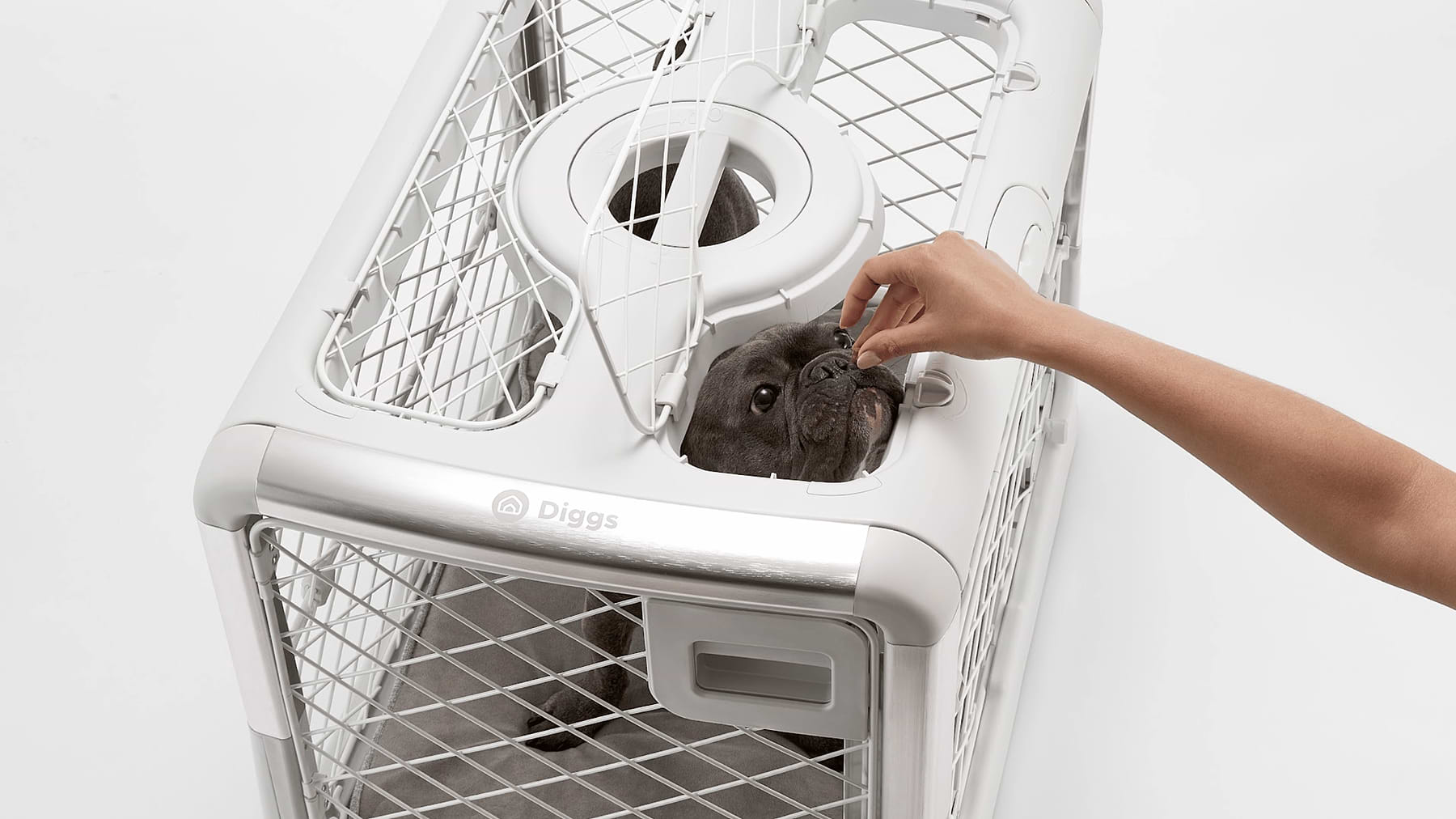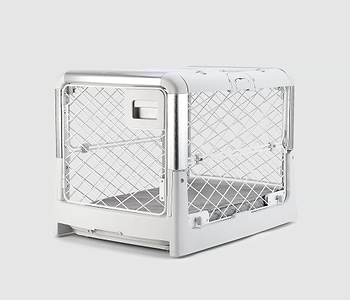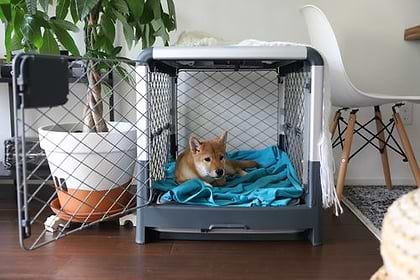Hearing your dog’s soft whimpers as you crate them up and step out of your house is heartbreaking for most. Actually, it’s the worst.
Even if your dog is less of a whimperer and more of a fierce barker, it’s hard feeling like you’re the cause of their stress. Crate anxiety, also known as dog separation anxiety, is real. Have no fear, though. There are ways to alleviate your pet’s distress when you have to leave the house.
Causes of Crate Anxiety
The first step is to have a thorough understanding of why your pup is experiencing these feelings at all. Crate anxiety is usually triggered when dogs are separated from their pet parents or the family member they’re attached to, and it may cause your dog to whine, howl, or engage in destruction like digging.
If your dog is used to you being in the house, they may experience crate anxiety when you lock them up and leave for work for a few hours. Traumatic events can cause crate anxiety as well.
If your dog was in a kennel for the majority of their life and is now a new member of your household, the crate might trigger post-traumatic stress. Puppies oftentimes experience crate anxiety, as they are unsure what a crate even is or why they are in there to begin with.
Symptoms of Crate Anxiety
How do you know if your dog is experiencing crate anxiety? There are a handful of symptoms that are associated with separation anxiety in pets.
Destructive behavior is one and is displayed as a variety of things, including urinating, defecating, barking, howling, chewing on things they shouldn’t chew on, or trying to escape the cage in an aggressive way. Excessive barking, panting, and drooling are three additional signs that your dog is experiencing crate anxiety.
Eight Tips to Reduce Dog Crate Anxiety
Here are our top tips to help you make crate training a calmer, easier process for you and your fur baby.
1. Find a Crate That Works for Your Pup
Your dog doesn’t have an issue with their crate. Your dog has an issue with you leaving the house. Once your dog officially associates the crate with you leaving, that’s when it becomes an issue for them. The goal is to make your dog feel as snug and cozy as possible when it’s time for you to head out.
Start by finding a comfortable and durable crate and crate size that’s right for your canine companion based on their breed, age, and size. Make your dog’s crate a safe haven— a home within a home.
It’s not supposed to feel like imprisonment of any kind or hold any sort of negative connotation. It should feel like a safe and secure den or shelter. Remember that a comfortable crate is an effective crate.
The basic rule of thumb is that your dog’s crate should be large enough for them to sit up, turn around and lie down in. If the crate is too big, they’ll have more room for destructive behavior like urinating or defecating. Keep it tight in there, but not too tight. Just snug enough. Make sure it also has a secure latch, as anxious dogs can be master escape artists.
Revol & Evolv
2. Desensitization
Desensitization of the crate is a behavior modification strategy that will help with your dog’s anxiety when you leave the house. Again, your mission is to associate positivity with the crate. Desensitization teaches your dog that crating is temporary and that you’re always going to come back. Keep in mind that this is a gradual process and can take a few months to lock-in.
Start the process of desensitization when you are home. Crate your pup and then step outside your door for a moment. Let your dog sit in the uncomfortable. If your dog stays quiet, come back in and reward them with a treat. After your pup is able to last a few seconds, turn that into a few minutes, then a few hours, so on and so forth, leaving for longer periods of time each time.
In addition, utilizing the crate while you are home is a good way to prevent your dog from following guardians from one room to the next. Allowing them to do this perpetuates their cycle of separation anxiety. Put them in their crate and spend time in another room. Again, let them deal with the separation and do not reward attention-seeking behaviors.
3. Positive Reinforcement
Positive reinforcement is the use of rewards like treats, verbal praise, toys, and play for desired behaviors. It is one of the most powerful tools for shaping and managing your dog’s behavior.
There are a couple of ways to positively reinforce crate use. Use your reward of choice (treats are usually the most high-value and effective) when your dog is near or inside their crate. Place the crate in an area of the house that is busy and where your household members spend a lot of time, like the living room or the dining room.
Consistently use a happy tone of voice and maintain uplifting energy when you’re near the crate. You can also try feeding your canine companion inside their crate as a way to positively reinforce. Again, you are teaching your dog that the crate is a wonderfully positive place to be.
4. Make It Comfortable
We’ve already discussed the importance of finding the right crate for your pup. Now, onto the next step. Think of your own bedroom for this one. Wouldn’t you want your sanctuary of a space to be filled with all of your favorite cozies? So does your pet! Essentially, the goal is to make your dog’s crate feel like home.
Create a secure and tranquil crating experience by incorporating a crate pad or a soft blanket. It’s even better if these items are lathered with your scent. You can even throw in an old t-shirt of yours to generate a space that feels familiar and safe. Supply your dog access to a bowl of water and their favorite toys, like a filled kong, to keep them company while you’re away. Make sure the crate has good ventilation.
5. Interactive Toys
Interactive toys or puzzle toys are a great way to ease your dog’s anxiety when they are in their crate and you are gone. They’re meant to challenge your pup, stimulate their mental capacity, and combat boredom. Before you invest in an interactive toy, make sure they are safe-for-crate, meaning that you can leave your dog with the toy unsupervised. Consult a vet before taking this step.
There are many different types of interactive toys that your dog is sure to love. There are toys that dispense kibble and toys that play hide-and-seek. There are toys with compartments for stuffing their favorite yummies. Test one or two before making an investment.
Tip: Make sure your toy of choice is not too challenging for your pup. A toy that’s too challenging might leave your dog frustrated and uninterested.
6. Calming Aids
Give your dog a calming aid to help combat their stress and anxiety. Go for soft chews that are made organically and with all-natural ingredients. As always, check-in with your vet before purchasing a calming aid for your pet.
You’ll want to make sure that it’s safe for your canine companion according to their age, breed, and weight. Not only do calming aids help support stress levels, but they also manage hyperactivity and help with fear and nervousness.
Consider pairing your calming aid with a multivitamin that provides your dog with omegas and probiotics to really set your dog on the right path. Remember, a physically healthy pup is a mentally healthy pup.
7. Crate Training Tool
Crate training tools are an effective way to help your dog love their little safe haven, even when you’re gone. Crate aids are meant to engage your dog and keep their attention, whether it’s through their favorite yummies (like peanut butter or bone broth), licking, or chewing.
Our Groov Crate Training Aid and Treat Spreads are the ultimate training combination, compatible with both Revol and traditional wire crates. Groov is the original crate training aid designed to encourage licking, a behavior that is proven to have a calming effect on dogs. It's a great enrichment tool and an easy way to help your pup love crate time—just add Treat Spread and attach it to their crate.
8. Your Energy
Have you ever considered that your pup might be mimicking your stressful energy? Your dog is very in tune with you and what you’re putting out into the world. If your house is chaotic, filled with screaming children, vocal pet parents, blasting music, so on and so forth, your dog is most likely going to feel that energy.
You’ll also want to keep departures and arrivals as low-key as possible. This is a tough one, as the first thing you want to do when you see your pet after being gone for hours is give them a million smooches and a gigantic hug. Try to refrain.
Your pup doesn’t need long hellos and long goodbyes. Keep it brief as the dragged-out attention worsens your pet’s anxiety the next time you leave. As difficult as it is, it’s actually effective to ignore your pet for ten minutes before you leave and ten minutes after you arrive home.
Summary
To conclude, there are a handful of ways to combat your dog’s crate anxiety. At the end of the day, we all want our pups to feel their very best, even when we are not home with them. Understanding what’s causing your pup their crate anxiety and what the symptoms of their stresses are is the first step to making them feel better.
Finding a crate that works for your pet is a great place to start. Using the method of desensitization and crate training while your home teaches your pet that their being in the crate is temporary and you’re always going to come back. Make the crate as comfortable as possible with all of your canine companion’s favorite things, like interactive toys, a crate training tool, blankets, or an old t-shirt of yours that reminds them of you.
Remember that your pup feeds off your energy. Keep yourself cool, calm, and collected so your pet stays cool, calm, and collected as well. With these tips, your dog will be well on their way.
Sources:
Does Your Dog Freak Out When You Leave? | Humane Society
Dog Crate Anxiety | Whole Dog Journal
Crate Training Your Dog | The Anti-Cruelty Society
Why interactive toys are good for your dog | Animal Wellness Magazine
You might also like
Crate training tips, stories and inspiration
View all blogsIn Your Diggs
Share your photos with #DiggsPet and tag us @DiggsPet on IG and TikTok.









